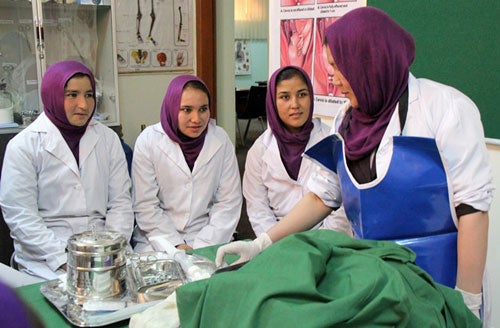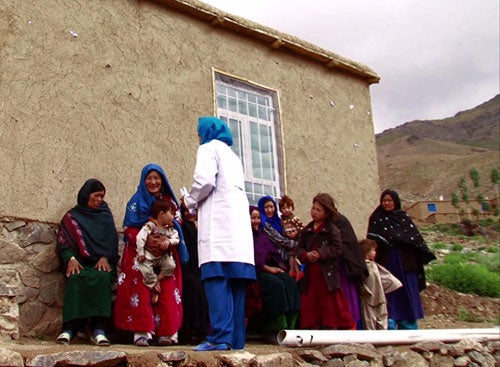News
The colour purple, changing the future of Afghan mothers
- 09 May 2014
News
KABUL, Afghanistan – Purple is the colour that midwifery students proudly wear in a small but revolutionary school in the busy Afghan capital, Kabul. In addition to a purple scarf, they have one other thing in common: They all come from one of the most remote and hard-to-reach areas of Afghanistan, Daikundi, a mountainous region dotted with isolated green valleys.
These midwifery students have been selected by their neighbours, communities and elder leaders to bring life-saving health care to the women and children of Daikundi.
In a country where a woman dies every two hours from pregnancy-related complications, midwives play a key role in promoting safe motherhood and delivering healthy babies. They embody the difference between life and death.
“My grandmother left this world delivering my father,” says Fatima, one of the midwifery students at the school. “I think this is the reason my family encouraged me to help my community by joining this programme, so no one has to live without a mother or a father.”
Fatima’s story is not unique in Afghanistan, where around 40 per cent of the population lacks access to health services within 10 kilometres – a three-hour walk – and women are left to deliver alone.
“I still remember a woman in my community who died because she couldn’t get to the hospital on time. Her placenta stayed inside after the child died during delivery. Her family tried to take her to the nearest hospital, and they carried her on the back of a donkey, but she died on her way there,” Masooma, another midwifery student, recalls.
“My uncle’s wife died during childbirth,” says Aqela. “She lost a lot of blood and the placenta was retained. There was no midwife and she died. Her two children survived, but they died months later because the adopting families didn’t have enough resources to take care of them.”

Fatima, Masooma and Aqela joined the Community Midwifery Programme eight months ago, following a tough selection process that involved their families, their communities and a written examination. The ones with the best marks enrolled in the programme, an initiative supported by UNFPA in collaboration with the Ministry of Public Health and support from the governments of Canada and Italy.
Thirty-six candidates passed the exam and joined the school in Kabul. These midwives represent a country that is changing and moving towards a future where every birth is safe.
The students and their families sign a commitment so the future midwife will return to the village once she finalizes her studies. They all realize how important their role will be when they move back to their communities after completing the two-year midwifery degree.
“We are really proud that we passed the exam. I was very nervous, but now I am very happy that I will be able to help the people living in my community,” says Aqela.
There are few opportunities for higher education for women in Daikundi. In Afghan culture, women are expected to stay at home and take care of the children, housework and their husband’s family. It is also difficult for them to travel without being escorted by a male relative.
When these women and girls move from remote areas like Daikundi to Kabul, they are challenging many of the social norms that rule women’s lives in Afghanistan.
Massoma says that, at first, her mother did not want her to enroll in the programme. “She thought my place was at home,” she recalls. “But I was lucky because my father and uncle convinced her by saying that I was going to get an education to help the community. My mother eventually agreed. Now she is happy, but we both miss each other,” she says.

“Different approaches were tried to bring basic health care services to the most remote areas of Afghanistan. Mobile health teams and doctors were sent through different initiatives, but none of these approaches alone worked out,” explains Dr. Ahmadullah Molakhail, Manager of the Community Midwifery Education project at the UNFPA office in Afghanistan. “We decided to actively involve the community in the process, guaranteeing their ownership from the very beginning.”
The project is a success, he says. The midwives return to their communities not only with life-saving skill sets, but also with a sense of status and empowerment.
Once they return home, each midwife is in charge of a Family Health House, a life-saving facility that provides essential maternal, newborn and child health care for 1,500 to 4,000 people.
These local midwives work with the community and family decision-makers to ensure that women receive preventive care services. They are also supported by two community health worker volunteers; one male and one female. They meet family members separately and sensitize them about the importance of different health issues, including family planning. In addition, they play an important role in reaching out to other girls and young women in their communities who have limited access to reproductive health information.
‘Family Health Houses’ are supported by mobile health teams, which offer technical and managerial assistance to the community midwife once or twice a month. They also vaccinate and provide primary health care.
Since 2009, the Ministry of Public Health, with support from UNFPA, has established 82 Family Health Houses and nine mobile health teams in the provinces of Faryab, Daikundi and Bamyan. By 2016, nine Family Health Houses will be functional in the province of Herat.
“We are trying to learn as much as we can. We will not care about cold or hot weather, or how difficult our work will be. We will take care of our communities, it is our duty,” says Masooma.
Some communities already have a name for them. They call them Angels.